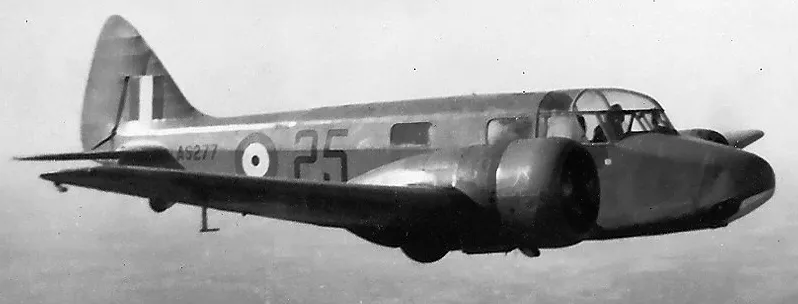Airspeed Oxford

Airspeed A.S. 10 Oxford Mk. II, RCAF (Serial No. AS277), 25, in flight over Saskatchewan, 1942.
The Airspeed AS.10 Oxford was a twin-engine monoplane aircraft developed and manufactured by Airspeed. It saw widespread use for training British Commonwealth aircrews in navigation, radio-operating, bombing and gunnery roles throughout the Second World War.
The Oxford was developed by Airspeed during the 1930s in response to a requirement for a capable trainer aircraft that conformed with Specification T.23/36, which had been issued by the British Air Ministry. Its basic design is derived from the company's earlier AS.6 Envoy, a commercial passenger aircraft. Performing its maiden flight on 19 June 1937, it was quickly put into production as part of a rapid expansion of the Royal Air Force (RAF) in anticipation of a large-scale conflict.
As a consequence of the outbreak of war, many thousands of Oxfords were ordered by Britain and its allies, including Australia, Canada, France, New Zealand, Poland, and the United States. Following the end of the conflict, the Oxford continued to achieve export sales for some time, equipping the newly formed air forces of Egypt, India, Israel, and Yugoslavia. It was considered to be a capable trainer aircraft throughout the conflict, as well as being used a general-purpose type. A large number of Oxfords have been preserved on static display. Wikipedia
CASPIR Aircraft Groups:
RCAF On Strength (821), Canadian Aircraft Losses (168)Oxford Mk. II AS347
Taken on strength at No. 2 Elementary Flying Training School at Fort William, Ontario. To No. 2 Training Command on 10 September 1941, for use by No. 35 Service Flying Training School at North Battleford, Saskatchewan. To No. 4 Training Command with this School on 10 November 1941. To Aircraft Repair in Edmonton for overhaul, 20 March to 12 August 1943. Back to No. 4 Training Command when completed. Still with No. 35 Service Flying Training School when it crashed on 2 December 1943, near North Battleford. Both RAF occupants killed. Note that Record Card reports crash date correctly, but lists write off date as 13 March 1943.
1941-08-20 Taken on Strength No. 2 Training Command 2019-08-20
1943-03-13 Struck off Strength Struck off, reduced to spares and produce 2020-09-22
1943-December-02 Accident: 35 Service Flying Training School Loc: Aerodrome Names: Cheetham | Clarke | Tomalin





 Commonwealth War Graves Commission
Commonwealth War Graves Commission Find-A-Grave.com
Find-A-Grave.com Library and Archives Canada Service Files (may not exist)
Library and Archives Canada Service Files (may not exist) North Battleford City Cemetery, Canada
North Battleford City Cemetery, Canada Oxford Trainer
Oxford Trainer Wikipedia Oxford Trainer
Wikipedia Oxford Trainer Harold A Skaarup Web Page
Harold A Skaarup Web Page
 RCAF.Info - RCAF Station North Battleford SK
RCAF.Info - RCAF Station North Battleford SK Saskatchewan Virtual War Memorial - Base History
Saskatchewan Virtual War Memorial - Base History